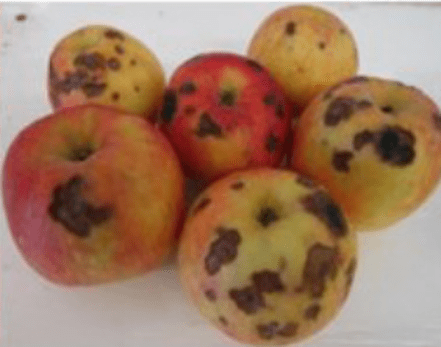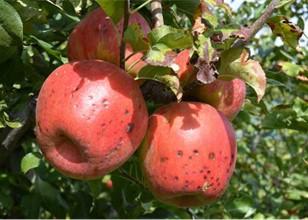Spots on Honeycrisp Apples: What are They and How to Differentiate Them?
What are physiological disorders?
Physiological disorders can be defined as abnormal growth patterns that can impact the external and internal conditions of fruit. They are not caused by insects, pests, or mechanical damage, but rather by environmental factors or production practices (pre-and postharvest). The development of physiological disorders will directly impact fruit quality, thus increasing fruit losses and reducing fruit marketability and profitability.
Particularly for Honeycrisp apples, there are different types of physiological disorders that can develop both on the tree as well as during storage, but only some of them are characterized by the development of spots in the skin and sometimes flesh. Some of these include bitter pit, lenticel blotch pit and lenticel breakdown. Being able to differentiate among these will be beneficial in identifying them properly and working to prevent their future incidence.
Physiological disorders characterized by development of spots in Honeycrisp apples
Bitter pit
Bitter Pit is mainly caused by a lack of Calcium within the apples in the early developmental stages of fruit growth. Calcium plays an important role in maintaining the cell walls, and when there is a shortage of calcium, the stability and integrity of these fruits’ cell walls is greatly diminished. In addition to calcium, high levels of nitrogen, potassium, and magnesium in the fruit peel of Honeycrisp apples are associated with the development of this disorder. Larger sized apples are more susceptible to developing bitter pit. Therefore, practices that contribute to increased fruit size and tree vigor should be taken with caution in Honeycrisp, due to the susceptibility of this cultivar to bitter pit development. Honeycrisp apples should also avoid being harvested too early, as these apples might last longer in storage, but have been associated with a higher incidence of bitter pit. Furthermore, the practice of fruit conditioning (maintaining Honeycrisp apples at 50°F for a week before cold storage) also increases bitter pit incidence, thus it is not recommended for orchards with high bitter pit history.
Bitter pit symptoms can be identified as they induce small depressions under the skin of the apple, and are characterized by sunken, irregular, with diffused edges darkened dry patches on the surface of apples. These are particularly located in the calyx end of the fruit. When consumed, these spots taste bitter.
Lenticel blotch pit

Lenticel blotch manifests in Honeycrisp mainly when fruit is harvested too late in the season. Its incidence also increases during hot summers (> 90° F), and due to excessive Nitrogen concentrations, as the latter decreases flesh fruit firmness. These spots can be identified by often hard, asymmetric brown patches near the calyx end of the fruit or the exposed side of the skin. They also produce dry brown sponge-like spots on the flesh of the apples. The development of lenticel blotch pit can be visible right before harvest, but it especially appears during storage. The development of lenticel blotch is also commonly associated with postharvest practices such as delayed conditioning, as these hasten ripening, and therefore increase and deepenthese depressions over time.
Lenticel breakdown

Lenticel breakdown occurs because of microcracks and abrasions on the epidermis layer of apples preharvest. These microcracks and abrasion can occur due to irregular water supply, as well as high humidity (> 95%), and low wind. Influxes of water in addition to low rates of evapotranspiration causes fluctuations in the amount of water within the apples and equate to this irregular water retention. Lenticel breakdown occurs mainly on the apple skin around the lenticels of the fruit, on the less exposed side of the fruit. They are characterized by precise circular darkened spots concentrated in multiple areas on the skin of the apple. Early symptoms are similar to small dimples, visible in angled light. During storage, as flesh firmness decreases, spots grow in depth and diameter and may combine. Flesh is not generally affected.
This article appears in September 2022, Volume 13, Issue 6 of the Vegetable and Fruit News.
